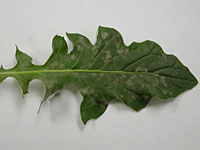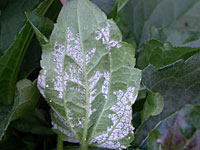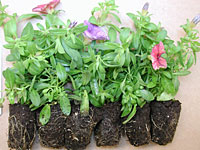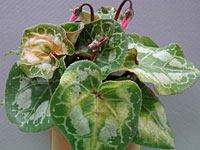Research
FOLIAR DISEASES:
Powdery Mildews
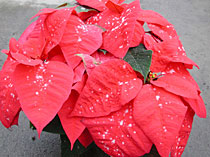
Powdery mildew on poinsettia.
Many ornamental crops from aster to zinnia are susceptible to powdery mildew fungi that destroy their aesthetic appearance. We work with a number of powdery mildew hosts, including poinsettia, gerbera, mini-rose, verbena, lilac and rosemary. We conduct greenhouse trials with biocontrols, biorationals and the latest reduced-risk chemistry, evaluating materials for plant safety and effectiveness. Our aim is to integrate biological, biorational and chemical controls together into programs that reduce the frequency of use of traditional fungicides and slow the development of fungicide resistance. Recent experiments have compared verbena cultivars for their susceptibility to Podosphaera xanthii, a powdery mildew fungus that is also able to infect squash and cucumber. Cultivar choice can eliminate much of the need for fungicide treatment in this crop. Ongoing field trials on lilacs have identified a number of hybrids with superior resistance to powdery mildew. We have recently identified a powdery mildew new to North America on vegetatively propagated petunias in the greenhouse.
Downy Mildews
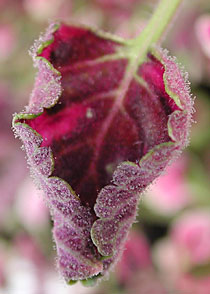
Downy mildew sporulating on undersides of coleus leaf.
We were recently part of the team that identified a new Peronospora sp. on coleus; this pathogen was differentiated from P. lamii using molecular methods and found to be the same organism causing a disease of basil in Europe. Symptoms of this downy mildew on coleus include mottling or conspicuous brown spotting, leaf curl, and leaf drop. In 2007, we inoculated 49 coleus cultivars in the greenhouse and later transplanted them to outdoor beds. All were found to be hosts: sporulation of the Peronospora sp. developed on the undersurfaces of the leaves but was often inconspicuous. The different cultivars, varied greatly in their symptoms; many remained attractive, others showed spotting and leaf curl, in a growing season with lower than usual humidity. We will continue to work with this coleus downy mildew and help growers to choose the less susceptible cultivars and to manage the disease with effective treatments during greenhouse production. Our studies on downy and powdery mildews are funded in part by the American Floral Endowment, and are conducted in collaboration with Mary Hausbeck at Michigan State University.
ROOT ROTS AND VASCULAR WILTS:
Our root rot and vascular wilt disease studies are funded largely through
the floral and Nursery Crop Research Initiative (USDA-ARS). This work
is done in collaboration with John Sanderson (Dept. of Entomology), Bill
Miller (Dept. of Horticulture) and Steve Wraight (USDA-ARS).
Pythium root rot
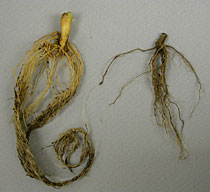
Geranium roots, pythium root rot on right
We are conducting surveys to identify the species of Pythium that are affecting the different floriculture crops, and determining the reservoirs of these organisms in the greenhouse. Pythium irregulare continues to be the most widespread pathogen, with the greatest number of ornamental hosts, but losses caused by P. aphanidermatum on chrysanthemum and poinsettias crops are quite extensive in summer months. We have recovered these pathogens from greenhouse floors as well as from the potting mix in containers of both symptomatic and healthy crops. Our research includes the fine-tuning of cultural, biological and chemical management strategies, and the monitoring of fungicide resistance in greenhouse flower crops. These studies are conducted in conjunction with Gary Moorman at Penn State University.
Phytophthora root and crown rot
We constantly monitor for greenhouse flower crop problems caused by oomycetes
in the genus Phytophthora. Diseases caused by P. cryptogea
in gerbera and P. nicotianae in pansy continue to be serious challenges.
Important new diseases caused by Phytophthora spp. have been identified
on calibrachoa, pansy, poinsettia, lavender and petunia in recent years.
Root and crown rot diseases caused by Phytophthora spp. are becoming
increasingly common during container production of herbaceous perennials.
We conduct trials to identify effective reduced-risk, biological and biorational
tools for the control of these diseases. Collaborative studies on improved
tracking and management of Phytophthora diseases are conducted in collaboration
with Steve Jeffers, Clemson University.
Thielaviopsis root rot (black root rot)
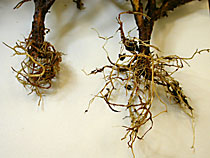
Thielaviopsis and Rhizoctonia on Gaillardia roots
Each year, more ornamental plant hosts are found with susceptibility to Thielaviopsis basicola. Most recently, we have observed rosemary and gaillardia that were seriously damaged by black root rot in container nurseries. Greenhouse crops of calibrachoas, pansies and violas are commonly challenged by this easily-misdiagnosed problem. We conduct studies on cultivar susceptibility to Thielaviopsis, as well as trials to evaluate potential chemical, biological and cultural controls.
Fusarium wilt
Our studies on Fusarium wilt of cyclamen aim to develop an integrated
control system utilizing pH, biocontrols, appropriate fertilizers and
reduced-risk fungicides to reliably protect plants. The Friends of Long
Island Horticulture have supported these studies. We are currently investigating
the overwintering ability of Fusarium oxysporum f. sp. chrysanthemi,
cause of Fusarium wilt of mum, along with Wade Elmer at the University
of Connecticut.

